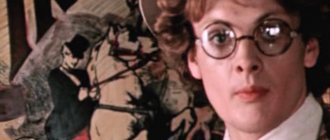Biography of Yuri Aizenshpis
Yuri Shmilevich Aizenshpis is a pioneer of domestic show business, who had an unsurpassed talent for producing and promoting pop stars, winner of the Ovation Award in the Best Producer category.
Russian producer Yuri Aizenshpis
At the age of 24, he went to prison for speculation on an especially large scale, smuggling and conducting illegal currency transactions, subsequently serving 17 years. Having been freed, he brought Kino, led by Viktor Tsoi, to the all-Union level and made it the main group in the country. After the musician’s death, he was the first to break the state’s monopoly on record production by releasing the band’s last mournful “Black Album.”
He was called the “godfather”, “show business shark”, “Karabas-Barabas of Russian pop music” for the win-win result of cooperation with him by artists who became mega-popular, but were obliged to obey him unquestioningly and give the main income from performances (at the initial stage - 90% , at the final stage – 60%). Among his wards were: the rock group “Technology”, “Dynamite”, singers Vlad Stashevsky, Linda, Katya Lel, Dima Bilan.
Biography[ | ]
Yuri Shmilevich Aizenshpis was born on July 15, 1945 in Chelyabinsk, where his mother Maria Mikhailovna Aizenshpis (1922-1991) was evacuated.
Parents Shmil Moiseevich Aizenshpis (1916-1989) and Maria Mikhailovna Aizenshpis worked in the Main Directorate of Airfield Construction (in GUAS).
Until 1961 they lived in a wooden barracks, and in 1961 they received an apartment in the prestigious Sokol district of Moscow. Since childhood, he was friends with classmate Vladimir Aleshin and went to the same sports school with him[10]. In his youth, he played sports: volleyball, handball and athletics. Due to a leg injury, he quit sports at the age of 16[1][4].
Career[ | ]
Since 1965, as an administrator, he collaborated with the rock group Sokol.
In 1968 he graduated from the Moscow Institute of Economics and Statistics with a degree in economics engineering.
Worked at the CSO (Central Statistical Office)[6].
On January 7, 1970, Yuri Aizenshpis was arrested. As a result of a search in his apartment, 17,865 dollars[6] and 10,000 rubles were confiscated.[6] Sentenced under Article 88 (Violation of rules on currency transactions) and 78 (Smuggling) for 10 years.[6]
After his release in 1977 on parole, he pulled off a new fraud, with counterfeit dollars, and sat down again. Finally released in 1987.[6] He was later acquitted on all counts.[6]
He worked in the creative association “Gallery” under the city committee of the Komsomol, organizing concerts of young performers.
From December 1989 until the death of Viktor Tsoi in 1990, he was director and producer of the Kino group[11]. In 1990, using borrowed funds, he released the “Black Album” (the last work of the Kino group), being one of the first to break the state monopoly on the release of records.
In 1991-1992 he collaborated with the group "Technology", then he was the producer of the groups "Moral Ex", "Young Guns"[12], singer Linda (1992-1993), singer Vlad Stashevsky (1993-1999)[13] (in the book "Vlad Listyev. Biased Requiem" it is mentioned that Aizenshpis was helped in promoting this project by criminal authority Alexander Makushenko, known as "Sasha the Gypsy"[14][15]).
Winner of the national Russian music award "Ovation" in the category "Best Producer" (1992, 1995).
Participated in the organization of the International Festival “Sunny Adjara” (1994) and in the establishment of the “Star” music award.
Producer of singer Inga Drozdova (1997), singer Katya Lel (1998), singer Nikita (1999-2001), singer Sasha (1999-2000).
The latest project is singer Dima Bilan[16][17][18][19].
Since 2000, he managed the affairs of the Dynamite group.
Since 2001 - General Director.
Aizenshpis had diabetes, so he tried not to gain weight[6].
On September 19, 2005, Aizenshpis was hospitalized at City Clinical Hospital No. 20 for examination, he felt better[6], and on September 20, 2005, at about 20:00, Yuri Shmilevich Aizenshpis died of a myocardial infarction at the age of 61[20].
He was buried near Moscow at the Domodedovo cemetery.
Personal life[ | ]
- Common-law wife - Elena Lvovna Kovrigina (born April 15, 1967) married Leonid Aleksandrovich Goyningen-Güne (born May 4, 1963) (director of television programs for TNT, Ren-TV, DTV channels), sued Dima Bilan due to non-fulfillment him of the agreement and the use of a pseudonym invented by Aizenshpis[21][22].
- Son - Mikhail Yuryevich Aizenshpis (born April 25, 1993), in February 2014, was detained by the police on suspicion of drug use, 1.5 grams of cocaine and a suitcase with money were seized from him[1][22][23][24 ][25][26].
Childhood and youth
The future professional, capable of creating bright and magnificent projects even from mediocre performers, was born on July 15, 1945 in Chelyabinsk. During the Second World War, his pregnant mother, Maria Mikhailovna, a native of Belarus, a participant in the partisan movement in the Gomel region, a graduate of the journalism department of Minsk University (though she never received a diploma), ended up there.
Yuri Aizenshpis with his parents
Father, Shmul Moiseevich, mistakenly recorded in the passport as Shmil, was a hairdresser originally from Poland. He ended up in the USSR fleeing the Nazis, then in the ranks of the Red Army he reached Berlin. Anti-Semitism did not affect Yuri or his family members at all; according to the producer, they did not face any harassment because of their Jewish nationality.
Yuri's parents met in 1944 in Moscow, where their family later moved. For a long time they wandered around the capital's barracks, but, working in the Main Directorate of Airfield Construction, they lived well for those times - they had a TV that cost two average salaries, a gramophone with a solid collection of records. In 1957, their daughter Faina appeared in their family, and in 1961 they received an apartment in the Sokol metro area.
Yuri Aizenshpis in childhood
The boy was a fan of handball, volleyball and the “queen of sports” - athletics. He attended a sports school, where many future champions and prominent sports figures studied with him. In particular, he was friends with Vladimir Aleshin (later general director of the Luzhniki Olympic complex). At the age of 16, due to a leg injury, he had to give up sports.
Yuri Aizenshpis in his youth
At that time, he was also fond of jazz and recorded compositions by Louis Armstrong, Ella Fitzgerald, John Coltrane, Woody Herman, and other leading musicians of the world. Later he became interested in rhythm and blues, which stood at the origins of rock and roll.
Biography
Yuri Shmilevich Aizenshpis was born a month after the end of the Great Patriotic War in Chelyabinsk. At that time, the producer's mother was evacuated there. Yuri Shmilevich comes from an unusual family. My father’s ancestors lived in Spain, but Shmil Moiseevich’s passport indicated Poland as his country of birth. Already as an adult, the man fled to the USSR, fearing reprisals from the Nazis.
Producer Yuri Aizenshpis
Interestingly, the real name of Yuri’s father is Shmul. The NKVD officer, filling out the passport, got it wrong. This is how Shmil Aizenshpis turned out. The man went through the Second World War and visited Berlin. However, the soldier was never wounded. Yuri Shmilevich’s mother’s biography is no less interesting. Maria Mikhailovna was born in Belarus.
After the death of her parents, she was given over to distant relatives to raise. Because of the outbreak of the war, I did not have time to obtain a diploma in journalism. Maria Mikhailovna joined the partisan detachment and almost fell into the hands of the Germans several times. In the post-war years she was awarded medals and orders.
Yuri Aizenshpis in his youth
Yuri's parents met at the Belorussky railway station in 1944. After the end of the war, Maria Mikhailovna and Shmil Moiseevich ended up in the Main Directorate of Airfield Construction. At that time, the Aizenshpis family lived well. In their house there was a TV and a gramophone with a large collection of records.
Until 1961, the producer's family lived in a wooden barracks, but then moved to an apartment located in the Sokol district of Moscow. Yuri Shmilevich was a sporty child and attended a sports school. The producer was a fan of handball, volleyball and athletics. I had to retire from professional sports due to a leg injury.
Yuri Aizenshpis
Yuri took his first steps as an administrator in his youth. In 1965, the man began collaborating with the rock group Sokol. Despite the obvious craving for show business, Aizenshpis received an economic education at the Moscow Economic and Statistical Institute.
The beginning of the way. Jail
Having received a certificate, the young man entered the Economic and Statistical Institute (MESI). While studying in 1965, he simultaneously began producing the rock group Sokol, arranging its semi-underground performances in a local cafe and the House of Culture, and with a job at the Tula Philharmonic and receiving official status, tours around the Union. Even then, he showed his natural business acumen - his monthly income reached more than 1.5 thousand rubles.
The group "Falcon", with which the career of Yuri Aizenshpis began
In 1968, Aizenshpis received a diploma as an engineer-economist and, after leaving the Philharmonic, began working at the Central Statistical Office with a salary of 115 rubles. At the same time, he was engaged in activities that today are called entrepreneurship, but were then considered illegal.
For example, Yuri bought tickets for his band’s concerts at the state price and sold them at a speculative price. Then he began to purchase currency for the purchase of scarce goods, and later - gold bullion in the commercial branch of Vneshtorgbank, and sold them several times more expensive. As a result of such fraud, he soon became a millionaire, and in 1970 he was sent to prison for 10 years.
Yuri Aizenshpis during his imprisonment
In 1977, Yuri was released on parole, but, having returned to his old ways, after 3 months he again found himself behind bars. Although it should be noted that thanks to his phenomenal communication skills and entrepreneurial talent, Eisenspitz was able to make his stay in the zone quite bearable. He was finally released from prison in 1987 and later received a not guilty verdict on all counts.
Music and production
Yuri Shmilevich's career as a producer began while still studying at the institute. Collaboration with a rock band did not help achieve the desired heights. Then Aizenshpis went to prison for conducting illegal currency transactions. After leaving prison, the producer found himself in the perestroika world, which became the starting point for developing a career in show business.
Lucky producer Yuri Aizenshpis
Meeting Alexander Lipnitsky allowed Aizenshpis to become the director of the Interchance festival. Gradually, the man studied the basics of behind-the-scenes life, identified methods of influencing musicians, and later moved on to producing.
“Promoting an artist is the functional responsibility of the producer. And here any means are good. Through diplomacy, bribery, threats or blackmail,” said Yuri Shmilevich.
This approach to the matter turned out to be successful. From an ordinary producer, Aizenshpis quickly rose to the rank of show business shark. Yuri began helping performers who wanted to be on the big stage. Not everyone suited Aizenshpis. The producer, lighting the stars, chose artists who could “hook” the viewer. A prerequisite was the presence of a repertoire. To promote musicians, Yuri Shmilevich used the media and television.
Yuri Aizenshpis and Viktor Tsoi
In 1988, the Kino group fell into the hands of Aizenshpis. By this time, the musicians had already reached a certain level on their own, but a professional approach to promotion was required. The collaboration of two talented people - Yuri Shmilevich and Viktor Tsoi - bore fruit.
The fame of the producer and musician soared to unprecedented heights. Two years later, Viktor Tsoi dies. Aizenshpis takes out a loan of 5 million rubles and releases the musician’s posthumous album “Black Album”. The disc's circulation exceeded 1 million copies. The producer earned 24 million from this project.
Musicians of the Kino group, Evgeny Dodolev and Yuri Aizenshpis at the presentation of the Black Album
Yuri Shmilevich's career developed rapidly. After “Kino” there was another group – “Technology”. In fact, Aizenshpis promoted the group from scratch. Young musicians became popular. For an unknown reason, after a year of working together, the paths of the producer and the wards diverge.
Already in 1992, Yuri Aizenshpis was recognized as the best producer in the country. A year after the official recognition, he meets Svetlana Gaiman, known under the pseudonym Linda. They worked for several months, after which Maxim Fadeev began promoting the singer.
For 6 years, Yuri Shmilevich collaborated with the famous singer Vlad Stashevsky in the 90s. Collaboration led to the recording of 5 albums. Aizenshpis increased Vlad’s popularity and recognition significantly. The musician was invited to major concerts and events in Russia and the USA.
Yuri Aizenshpis' track record includes such stars as Katya Lel, Nikita, and the Dynamite group. The main achievement in the work of the producer was Dima Bilan. Under the leadership of Yuri Shmilevich, they learned about the artist in Russia.
Yuri Aizenshpis and Dima Bilan
Aizenshpis described bright moments of life and work in books. The producer published “Lighting the Stars. Notes and advice from a show business pioneer,” “From a black marketeer to a producer. Business people in the USSR" and "Viktor Tsoi and others. How the stars light up." In memory of the producer, a program was broadcast on the TVC channel called “Wild Money.”
Show business career
Upon release, Yuri fell into a deep depression and suffered a heart attack - at 42 he had nothing: no apartment, no family, no money.
He began organizing performances for aspiring performers, working in the creative youth association “Gallery” under the city committee of the Komsomol. Over time, his friend musician and director Alexander Lipnitsky, stepson of V.M. Sukhodrev, a personal translator for the country's top leaders (including Brezhnev, Khrushchev, Gromyko, Gorbachev), helped him get the position of director of the Interchance festival. Initially, he began collaborating with the Kino group, which recorded the album Blood Type. He brought the team to the big stage, organized participation in the popular television programs “Vzglyad” and “Morning Mail”, which the whole country watched in those years, involved the press and turned Tsoi into a superstar. After the tragic death of the singer in 1990, taking out a loan of 5 million, Eisenspitz released his posthumous disc and as a result earned authority and 24 million rubles.
Yuri Aizenshpis about Viktor Tsoi and working with the Kino group In 1991, having taken up his second project - the Tekhnologiya group, the producer showed that even performers of average talent can be made into stars. A year later, he received the Ovation Award as the country's best producer and began producing the Moral Code and Young Guns groups. In 1993, he worked on the promotion of singer Linda, who later worked under the supervision of composer Maxim Fadeev.
Yuri Aizenshpis on the set with the group "Technology"
Then, for six years, Eizenshpitz collaborated with Vlad Stashevsky. Each of the musician's five albums released during this period became a bestseller. The artist was invited to all major events in the country, and in 1997, at the invitation of the US Senate, he performed in front of an audience of 20 thousand in Brooklyn Park.
Yuri Aizenshpis and Vlad Stashevsky
In 1995, the producer was again awarded the Ovation Prize for his creative achievements, and in 1997, his track record included such stars as Katya Lel, Inga Drozdova, then singer Nikita, Sasha, and the Dynamite group. In 2001, Yuri took the post of general director of the largest production company Media Star. In addition, he showed himself as a writer, presenting the autobiographical book “Lighting the Stars.”
Yuri Aizenshpis with the Dynamite group
The last and main project of Yuri Shmilevich was Dima Bilan. Unlike Stashevsky, Aizenshpitz called him “a real talent” and not a “synthetic product.” Yuri did not live literally two days before the triumph of his pupil, who received the MTV RMA-2005 award in the categories “Best Performer” and “Best Artist”. Dmitry went on stage to receive the award along with Misha, the producer’s 8-year-old son, and the audience observed a minute of silence in memory of Yuri.
Yuri Aizenshpis and Dima Bilan
Producer career
It’s safe to say that Yuri Shmilevich’s professional biography began during his student years. His first step was collaboration with a group that performed its compositions in the rock style. This did not bring Aizenshpis success. He was caught in illegal currency transactions, for which he went to prison. After serving his assigned term, Yuri found himself in the world of perestroika of the Soviet Union. At this time, show business began to actively develop.
When Yuri met Alexander Lipnitsky, he did not yet know that he would become the director of the Interchance festival.
Aizenshpis did not immediately switch to producing; he carefully studied how the performers live behind the scenes, how he could influence the musicians’ condition. Yuri Shmilevich understood for himself the main goal of the producer - to promote the artist, to give him a start in creative life. Aizenshpis found “highlights” in the artists he produced. To promote to the big stage, the producer uses all means, collaborating with advertising on television and in the media.
Aizenshpis produced the Kino group, which was already an established group of musicians. Soloist Viktor Tsoi and Yuri Shmilevich managed to promote young performers. After 2 years of successful cooperation, Viktor Tsoi died. The producer released a record dedicated to the soloist and composer using a five-million dollar loan. Aizenshpis managed to increase income from the sale of Tsoi’s music by 19 million rubles.
The next successful group, thanks to the famous producer, was the group “Technology”. He led these guys from the very beginning of their existence. A year later he managed to promote “Technology”. Yuri Shmilevich became the best of all producers. Aizenshpis handed over the singer Linda, who had been promoted by him for several months, into the hands of Maxim Fadeev.
During 6 years of collaboration with performer Vlad Stashevsky, 5 albums were recorded. In practice, it turns out that the singer and producer released an album every year. Vlad visited concerts not only in major cities in Russia, but also in America. Katya Lel and Dima Bilan, the Dynamite group and Nikita owe their promotion to Aizenshpis.
Yuri Shmilevich wrote several manuals and advice for producers. His books contain descriptions of methods for promoting beginning artists that Aizenshpis himself mastered.
Personal life of Yuri Aizenshpitz
There were rumors in the musical environment about the homosexuality of the producer and some of his charges. However, they did not find confirmation and did not prevent his affair with Elena Lvovna Kovrigina, 22 years younger. In 1993, the couple had a son, Misha.
Yuri Aizenshpis with his wife and son
Aizenshpis, a loner by nature, preferred to live in a large separate apartment, although his son, who lived with his mother in a neighboring house, visited him very often. His loving father spared no expense on his education - from an early age the boy learned foreign languages and traveled a lot.
Yuri Aizenshpis and his son
In February 2014, the young man was detained in Moscow on suspicion of drug use. They found a suitcase with money and 1.5 g of cocaine in his possession, but after interrogation, he was released on his own recognizance. In November of the following year, the young man was discovered in the Northern capital. He left home in January and, according to his mother’s statement, was wanted (as someone who had lost contact with relatives).
Death
In 2005, the producer played a minor role in the film “Day Watch,” which received notoriety due to the misfortunes that befell the project participants (in particular, Maria Poroshina sprained her leg, Alexey Maklakov lost his mother and suffered a micro-infarction, Konstantin Khabensky lost his father and subsequently his wife) .
The grave of Yuri Aizenshpis
During filming, Aizenshpis felt unwell. On September 19, he was hospitalized and underwent the necessary medical procedures that improved his condition. However, the next day he died from acute heart failure. In memory of the producer, for whom the main thing in show business was the creative process, and not money, a TV show was broadcast on the TV Center channel as part of the documentary series “Wild Money” (2016-2017). "Wild Money" program











